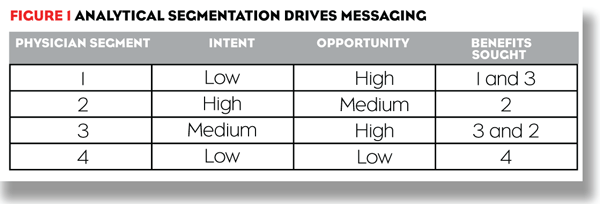Honestly—when was the last time you bothered to read, watch, or listen to a product message that wasn’t relevant to you? Now, imagine a physician who is looking for a better tolerability profile for her adolescent patients with a particular condition. If she gets the one-size-fits-all “onset of action” message, it’s clearly a relationship-building opportunity lost.
We hear a lot about data-driven marketing’s ability to translate HCP preferences and attitudes to more tailored messaging. Although a great idea, there are few detailed examples. It’s not as easy to do as you might think, and the data-driven approach works better for some channels than others. To maximize insights, you need to ask the right questions, provide consistent input, and do the right kind of data mining.
What follows is a schematic analysis of an optimal data-driven platform and analytic process, as applied to an eDetail Message Optimization exercise for a mature product in a “not so differentiated” class of drugs.
THE PLATFORM
“Best practice” eDetails are uniquely able to uniformly profile and ask key questions of HCPs, while simultaneously educating, promoting to, and showcasing key data. And eDetails can use branching logic to deliver personalized messages on the fly and marry Rx data for ROI analysis and message optimization. Here are the six steps to data-driven message personalization:
- Ask the right questions to truly understand HCPs’ needs and attitudes.
- Employ appropriate data mining tools to reveal hidden patterns.
- Identify key drivers, and segment HCPs accordingly.
- Assess which HCPs are in your camp and optimize messaging/targeting.
- Deliver the right message to the right HCP via intelligent branching.
- Provide message-specific ROI to show Rx lift by message.
A MATURE BRAND CASE STUDY: KEY INSIGHTS AND OPTIMIZATION RESULTS
Brand Challenge: Identify the best opportunities and most effective eDetail messaging for a mature brand (Brand X) in a relatively undifferentiated market, measured against a competing Brand A.
Solution: Effectively mine/model thousands of MD responses for data patterns that yield marketing and messaging insights. In this case, a decision-tree analysis revealed attributes and attitudes that most differentiated disparate groups of MDs.

Results: The team identified four pre- scriber segments by matching the benefits the provider sought from treatment and those Brand X delivers (Opportunity) and by gauging changes in intent to prescribe post eDetail (Intent). For proprietary reasons, the four therapeutic benefits are identified only as Benefits 1, 2, 3, and 4. Benefit 1 is unique to Brand X: the challenge is to accentuate its perceived importance. Brand X outperforms Brand A in Benefit 2. Both products deliver about equally on Benefit 3, but the competing Brand A owns market mind-share. And Brand X does not deliver Benefit 4. Data-mining revealed that the market breaks down like this (Figure 1):
The first three segments represent unique messaging opportunities for the brand—driven more by need than by specialty. Physicians in Segment 1 (70% lower- to mid-writing PCPs), for example, were not big prescribers of Brand X, despite their alignment with core brand benefits. This group was best served by an education-based aware- ness message that utilized a brief KOL video extolling Benefit 1.
While Segment 2 received a brief reinforcement message, Segment 3 (65% specialists) required an eDetail with a one-two punch that led with convincing data supporting parity with the market leader in Benefit 3 and superior delivery of Benefit 2, Brand A’s strength. (This is a little like a sports car enthusiast who wants to be assured of “great handling” before talking about “top speed.”)
For the low-intent, low-opportunity Segment 4 (10% of all MDs), there was very little potential for conversion. The Brand team decided to pull marketing support for this group, and spend the funds on best customers and likely prospects.
Conclusion: The ROI for this campaign was in the 400% range (a nice return for a mature brand). Next steps include “message-specific” ROI analysis (to determine incremental lift), incorporating ongoing learnings, and ultimately using these insights to support other tactics in the never-ending quest to deliver the right message to the right HCP at the right time.




